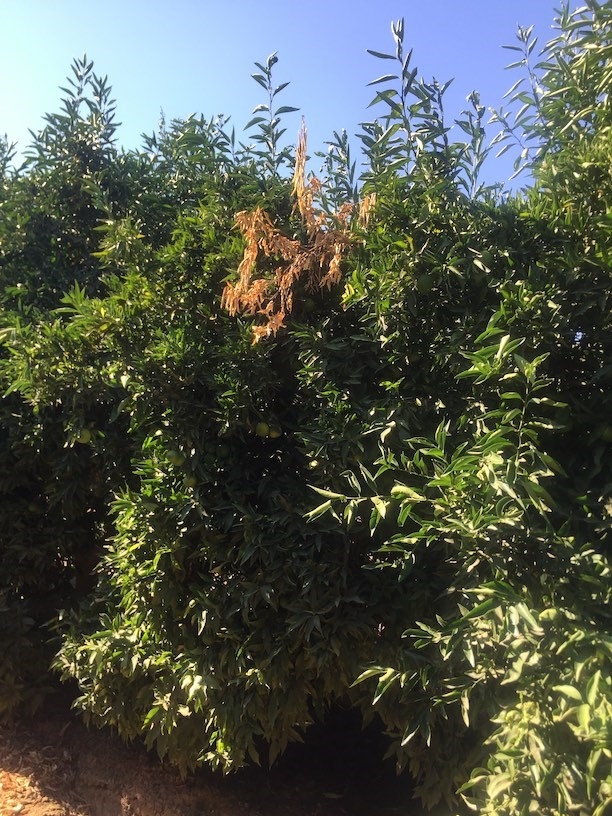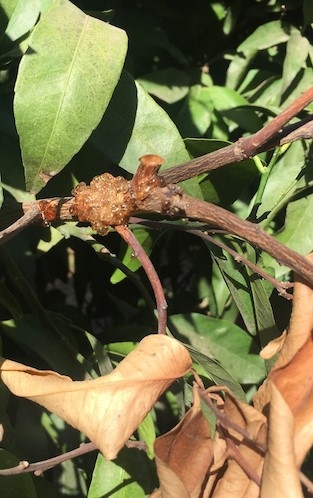
Posts Tagged: anthracnose
Colletotrichum Shoot Dieback of Citrus
|
Figure 1: Citrus shoot dieback (top) and gummosis (bottom) caused by Colletrotrichum. |
A new disease of citrus has been found in the main growing regions of the Central Valley of California. The causal agents of this disease were identified as species of Colletotrichum, which are well-known pathogens of citrus and other crops causing anthracnose diseases. Several growers and nurserymen in various orchards in the Central Valley first noticed the disease in 2013. Symptoms include leaf chlorosis, crown thinning, gumming on twigs and shoots dieback, and in severe cases, death of young trees. The most characteristic symptoms of this disease are the gum pockets, which appear on young shoots either alone or in clusters and the dieback of twigs and shoots (Fig.1). Field observations indicate that symptoms initially appear during the early summer months and continue to express until the early fall. These symptoms were primarily reported from clementine, mandarin, and navel orange varieties. In order to determine the main cause of this disease, field surveys were conducted in several orchards throughout the Central Valley. Isolations from symptomatic plant samples frequently yielded Colletotrichum species. Morphological and molecular phylogenetic studies allowed the identification of two distinct species of Colletotrichum (Colletotrichum karstii and Colletotrichum gloeosporioides) associated with twig and shoot dieback. Interestingly, these Colletotrichum species were also isolated from cankers in larger branches. Although C. gloeosporioides is known to cause anthracnose on citrus, a post-harvest disease causing fruit decay, it has not been reported to cause shoot dieback of citrus. C. karstii however has not been reported previously from citrus in California and our research team is currently conducting field and green house studies to determine the pathogenicity of this species in citrus. At present, it is unclear how widespread this disease is in California orchards or how many citrus varieties are susceptible to this disease. Pest control advisors are monitoring citrus trees for the presence of the disease in the Central Valley (particularly clementine, mandarin, and navel varieties) during the early summer months. Continuing research led by Dr. Akif Eskalen in collaboration with Dr. Florent Trouillas is focused on further understanding the biology of the fungal pathogens as well as factors influencing disease expression in order to develop management strategies against this emerging disease.
Shoot and Twig Dieback of Citrus
Recently, an outbreak of shoot and twig dieback disease of citrus has been occurring in the main citrus growing regions of the Central Valley of California (Fig 1). The causal agents of this disease were identified as species of Colletotrichum, which are well-known pathogens of citrus and other crops causing anthracnose diseases. At this time, it is unclear how wide-spread the disease is in California citrus orchards, but surveys are being conducted to evaluate the spread of this disease in orchards.
The disease was first noticed in 2012 by several growers and nurserymen in various orchards in the Central Valley. Symptoms included leaf chlorosis, crown thinning, gumming on twigs and shoot dieback, and in severe cases, branch dieback of trees (Fig.2). The most characteristic symptoms of this disease are the gum pockets which appear on young shoots either alone or in clusters and the dieback of twigs and shoots (Fig.3). These symptoms were primarily reported from clementine, mandarin, and navel orange varieties. In order to determine the main cause of this disease, field surveys were conducted in several orchards throughout the Central Valley. Isolations from symptomatic plant samples frequently yielded Colletotrichum species.
Field observations indicate that symptoms initially appear during the early summer months and continue to express until the early fall. Trees showing dieback and gumming symptoms characteristic of this disease are usually sporadic within an orchard and generally only a few twigs or shoots are affected within a tree. Morphological and molecular phylogenetic studies allowed the identification of two distinct species of Colletotrichum (Colletotrichum karstii and Colletotrichum gloeosporioides) associated with twig and shoot dieback. Interestingly, these Colletotrichum species were also isolated from cankers in larger branches. Although C. gloeosporioides is known to cause anthracnose on citrus, a post-harvest disease causing fruit decay, it has not been reported to cause shoot dieback of citrus. C. karstii however has not been reported previously from citrus in California and our laboratory is currently conducting field and green house studies to determine the pathogenicity of this species in citrus.
At present, it is unclear how widespread this disease is in California orchards or how many citrus varieties are susceptible to this disease. Pest control advisors are advised to remain alert and monitor citrus trees for the presence of the disease in the Central Valley (particularly clementine, mandarin, and navel varieties) during the early summer months. Continuing research lead by Dr. Akif Eskalen (UC Riverside) in collaboration with Dr. Florent Trouillas (Kearney Agricultural Research and Extension Center), Dr. Greg Douhan (UCCE Farm Advisor Tulare County), and Craig Kallsen (UCCE Farm Advisor in Kern County) is focused on further understanding the biology of the fungal pathogens as well as factors influencing disease expression in order to develop management strategies against this emerging disease.
Shoot dieback symptoms on Clementine
Branch dieback symptoms on Clementine
Gumming symptoms on Clementine
(photos: A. Eskalen)
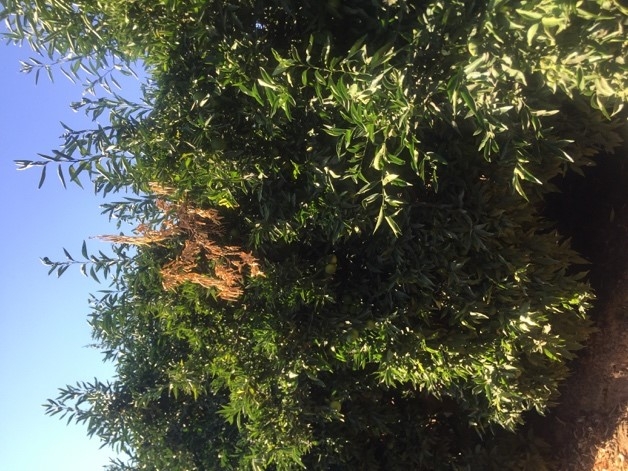
shoot dieback on clementine
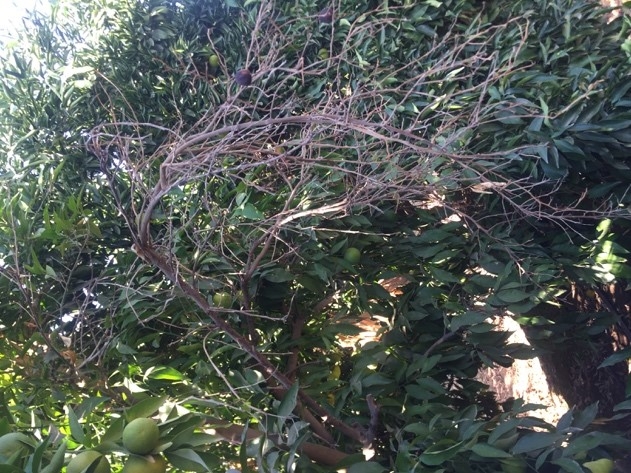
branch dieback on clementine
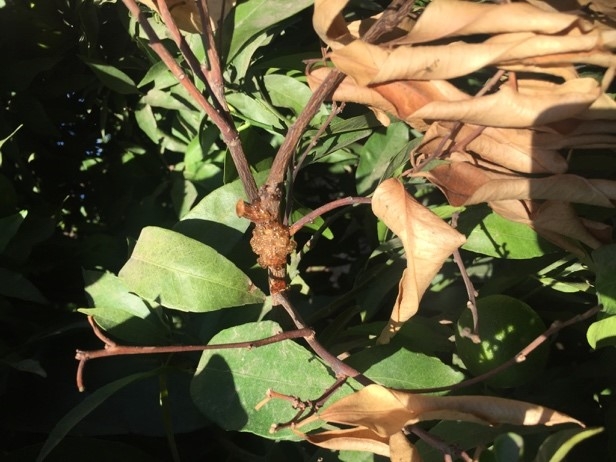
gumming symptoms on clementine
Citrus anthracnose or tear staining of fruit
It's been a dry year and you don't expect it, but there's been a lot of "tear staining" of fruit. It has become most apparent this spring with the dew along the coast and the humidity. I've had a number of calls from growers this year because it has downgraded their fruit. One 'Meyer' lemon grower has had virtually all of her fruit affected. Here's the word from the IPM website - http://www.ipm.ucdavis.edu/PMG/r107102111.html
Citrus
Anthracnose
Pathogen: Colletotrichum gloeosporioides
In this Guideline:
Symptoms
Symptoms of anthracnose on citrus include twig dieback, premature leaf drop, dark staining on fruit and postharvest fruit decay. Dying leaves and twigs become covered with dark fungal spores by which the pathogen spreads.
Anthracnose may blemish the rind tissue of mature Valencia and navel oranges, grapefruit, and occasionally lemon. The disorder affects mainly fruit on stressed trees with old, dead wood.
Comments on the Disease
The anthracnose fungus usually infects weakened twigs. The disease is most common during springs with prolonged wet periods and when significant rains occur later in the season than normal. During wet or foggy weather, anthracnose spores drip onto fruit, where they infect the rind and leave dull, reddish-to-green streaks on immature fruit and brown-to-black streaks on mature fruit (tear stains). Anthracnose tearstain often occurs with Septoria spot. The Septoria fungus itself and possibly certain environmental conditions may also cause tear staining. The stain cannot be washed off, but the disorder is generally not severe enough to require preventive actions. Certain conditions, however, such as applications of insecticidal soaps, which damage the protective wax on the fruit peel, can increase the severity of this disease.

citrus tear stain

